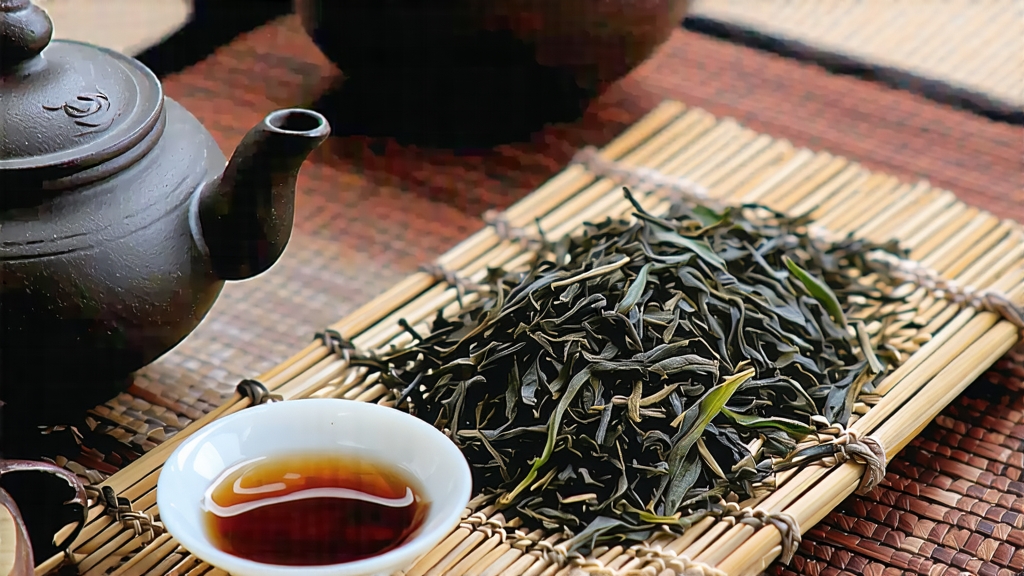
Ask most tea lovers to name a Chinese black tea and they will answer Keemun or Yunnan Gold; few realize that the very first black tea ever created was Lapsang Souchong, born in the cool gorges of the Wuyi Mountains in northern Fujian around 1568. Legend says a passing army commandeered a Qing-era tea factory overnight, forcing farmers to dry their half-oxidized leaves quickly over fresh pine fires so they could reach market before the leaves spoiled. The accidental smoke infusion proved wildly popular with Dutch traders who carried it to Europe, where it became the “bohea” that filled the cups of London coffee-houses and ignited Britain’s centuries-long obsession with black tea. In short, every modern breakfast blend owes its existence to those resin-scented leaves.
True Lapsang Souchong is still produced only within the 60 km² core of the Wuyi UNESCO World Heritage site, an amphitheatre of granite cliffs and subtropical forest known locally as “the place where rock and cloud embrace.” The original cultivar is Xiao Zhong (small-leaf) Qunti, an indigenous shrub that clings to thin mineral soils, yielding leaves barely 2 cm long yet packed with lilac-like aromatics. Two protected designations exist: Zheng Shan Xiao Zhong, picked above 800 m within the nature reserve and smoke-dried over马尾松 (Masson pine), and Wa Shan Xiao Zhong, grown on lower terraces outside the park and often flavored with artificial smoke essence. Purists insist only the former deserves the name.
Harvest begins in late April when the mountain air is still crisp. One bud plus two leaves is plucked at dawn, then withered on bamboo racks inside wooden huts heated by gentle charcoal fires. Rolling follows, but unlike the CTC (crush-tear-curl) method used for Assam, the leaves are twisted by hand until the cell walls rupture just enough to release enzymes for oxidation. The crucial step is the 6–8 hour smoke-drying phase: fresh pine logs are lit in a sunken pit, the flames are smothered with damp mats, and the aromatic smoke is channeled through a brick corridor where the tea rests on multi-tiered bamboo sieves. Volatile compounds such as longifolene and guaiacol permeate the leaf, locking in a flavor that is simultaneously malty, fruity, and unmistakably resinous. Finally the tea is sorted by eye, removing stems and yellow leaves, then rested for one month so the smoke softens into a subtle background note.
Westerners often expect an aggressive campfire punch, but a properly crafted Lapsang Souchong is surprisingly nuanced. Dry leaf aroma recalls dried longan, pine sap, and a whisper of lavender. Once brewed, the liquor glows amber-orange and delivers layers: front-palate sweetness of honeyed peach, mid-palate minerality reminiscent of Wuyi rock oolong, and a lingering coolness like camphor. The smoke is present yet integrated, more cedar cigar box than kipper.
To unlock these subtleties, abandon the boiling-tea-bag approach. Use a 120 ml gaiwan or small Yixing pot, 4 g of leaf, and 90 °C water. Rinse once to awaken the leaves, then steep 5 s, 8 s, 12 s, adding three seconds each subsequent infusion. The tea will yield eight to ten rounds, evolving from smoky fruit to orchid nectar before finally fading into clean river-stone notes. If you prefer Western style, measure 2 g per 250 ml, infuse three minutes at 95 °C, but expect only two good steeps.
Pairing food with Lapsang is an adventure. Its phenolic structure cuts through oily fish—try it with grilled mackerel or smoked salmon. The pine resonance also complements roasted game; Chinese chefs serve it alongside tea-smoked duck, rubbing the bird’s cavity with crushed leaf before hanging it over camphor twigs. For dessert, match a strong infusion to 70 % dark chocolate or a buttery almond tart: the cacao’s bitterness echoes the tea’s ember notes, while the pastry fat softens any remaining sharpness.
Quality markers are visible even before brewing. Superior leaf is glossy, strip-shaped, and